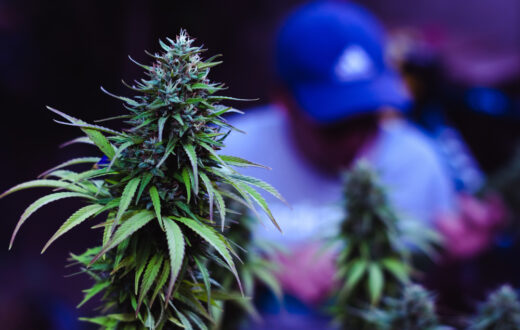Introduction to Cafe Racer Autoflower
Cafe Racer Autoflower is recognized as a standout strain within the growing world of cannabis cultivation. Developed specifically for those seeking a blend of speedy harvests and robust effects, this autoflowering variety has become increasingly popular among both novice and experienced growers. Autoflowering cannabis strains, like Cafe Racer, are distinguished by their ability to transition from the vegetative stage to the flowering stage without the need for controlled lighting cycles. This unique characteristic allows growers to cultivate their plants in a wide range of environments, making the growing process more accessible and efficient.
The significance of autoflowering strains, particularly Cafe Racer Autoflower, in contemporary cannabis cultivation cannot be overstated. These strains thrive under varying light conditions, enabling growers to achieve multiple harvests within a single growing season. The rapid growth cycle, typically taking between 8 to 10 weeks from seed to harvest, makes autoflowering strains ideal for those with limited time or space. This characteristic has garnered attention among cultivators looking for high-yield options that do not compromise on quality.
The target audience for Cafe Racer Autoflower primarily includes cannabis growers who value efficiency, reliability, and high yields. With its excellent adaptability and resilience, Cafe Racer has become a favorite for individuals looking to maximize their productivity with minimal effort. As a result, this strain not only caters to seasoned growers seeking new challenges but also appeals to beginners who may be intimidated by the complexities of traditional cannabis cultivation methods. As we delve deeper into the intricacies of how to grow Cafe Racer Autoflower, it becomes clear that understanding its unique traits and cultivation requirements will empower growers to achieve remarkable results.
Understanding Autoflowering Cannabis: Basics and Benefits
Autoflowering cannabis plants, such as the Cafe Racer autoflower, represent a distinct category of cannabis cultivation that operates under different principles compared to photoperiod strains. These plants are genetically engineered to transition from the vegetative stage to the flowering stage automatically, independent of light cycles. This unique characteristic is derived from the Ruderalis strain, which has adapted to grow in diverse climates with varying daylight hours. As a result, growers can enjoy more flexibility in their cultivation plans.
One of the primary benefits of cultivating autoflowering strains like Cafe Racer is their shorter life cycle. Typically, these plants can go from seed to harvest in as little as 8 to 12 weeks, significantly reducing the time invested compared to traditional photoperiod varieties, which may require several months to mature. This fast turnaround makes autoflowering cannabis particularly appealing for both novice and experienced growers looking to maximize their yield within limited time frames.
Moreover, autoflowering cannabis plants generally have lower light requirements, which can make them easier to grow in non-ideal conditions. They can thrive under minimal lighting and can be cultivated indoors or outdoors with relative ease. This versatility allows growers in various environments to successfully cultivate Cafe Racer autoflower without the need for elaborate lighting setups. Furthermore, the robustness of autoflowering strains means they are often more resilient to pests and diseases, contributing to a more straightforward growing experience overall.
In essence, understanding the underlying genetics and advantages of autoflowering cannabis provides a solid foundation for growers interested in strains like Cafe Racer. The combination of quick growth, adaptability, and lower maintenance requirements positions these plants favorably in the cannabis cultivation landscape.
Choosing the Right Seeds for Cafe Racer Autoflower
To successfully cultivate Cafe Racer Autoflower cannabis, it is imperative to begin with selecting high-quality seeds. The foundation of any successful grow starts with genetics, which can significantly influence the overall development and yield of the plants. Therefore, understanding how to select seeds is crucial for any aspiring grower.
Firstly, it is advisable to source seeds from reputable seed banks. Reputable sources are typically recognized within the community for their quality and consistency. Look for seed banks with positive reviews, established histories, and transparency regarding their breeding practices. Ensure they specialize in autoflower strains, with particular emphasis on the Cafe Racer variety. Many seed banks provide detailed descriptions, along with cultivation guides that can further aid in your growing journey.
Secondly, assessing the characteristics of the seeds is vital. High-quality Cafe Racer Autoflower seeds should appear firm, plump, and dark in color. Seeds that are pale or cracked may indicate poor genetics or improper storage conditions, which could adversely affect germination rates. Additionally, reputable seed banks often provide germination guarantees, assuring the viability of their seeds.
Furthermore, it is important to understand the genetic stability of the strain. Reliable seed banks will usually offer a description of the genetic lineage, which can help gauge the potential consistency of growth and robustness of the plants. Strain stability refers to the tendency of a genetic line to produce uniform plants; selecting seeds from a stable strain contributes to a more productive harvest.
In conclusion, choosing the right seeds for Cafe Racer Autoflower is a blend of research and careful consideration. By focusing on reputable sources, assessing seed characteristics, and understanding genetic stability, you will lay a strong foundation for a successful growing experience.
Ideal Growing Conditions for Cafe Racer Autoflower
Successful cultivation of Cafe Racer autoflower plants hinges on providing their ideal growing conditions. Understanding the fundamental factors such as temperature, humidity, soil type, and nutrient requirements is crucial for maximizing yield and health. For optimal growth, these plants thrive in temperatures ranging from 70°F to 80°F (21°C to 27°C) during the day, with slightly cooler nighttime temperatures. Monitoring these temperature ranges can prevent stress and promote vigorous growth.
Humidity also plays a significant role in the growth of Cafe Racer autoflower. During the vegetative phase, maintaining humidity levels around 40-60% is beneficial, as this fosters healthy leaf development. Conversely, as the plants transition into the flowering stage, decreasing humidity to about 40% can help prevent mold and pests, ensuring the integrity of the buds. A careful balance of these environmental parameters can greatly influence overall plant health.
Soil type is another critical factor that can impact the growth of Cafe Racer autoflower. These plants prefer well-draining, nutrient-rich soil that is slightly acidic to neutral (pH 6.0-7.0). Incorporating organic matter like compost can enhance soil nutrition and improve drainage, contributing to stronger plant development. Additionally, feeding the plants with a high-quality nutrient solution, particularly during the flowering phase, further supports healthy bud formation and growth.
When considering growing methods, it’s important to differentiate between indoor and outdoor cultivation. Indoor setups allow for tighter control over environmental conditions, making them ideal for meticulous growers. Conversely, outdoor cultivation offers natural sunlight and can result in larger yields. Understanding the nuances of both methods can aid growers in establishing the most suitable environment for thriving Cafe Racer autoflower plants.
Nutrient Management for High Yields
Effective nutrient management is vital when learning how to grow Cafe Racer Autoflower, as the well-being and productivity of these plants heavily depend on the availability and balance of nutrients. The essential nutrients for cultivating Cafe Racer Autoflower can be categorized into macronutrients and micronutrients. Understanding these nutrients will enable you to maximize yield and promote healthy growth.
Macronutrients are the primary elements required in larger quantities, including nitrogen (N), phosphorus (P), and potassium (K). Nitrogen is crucial for vegetative growth, enhancing leaf and stem development. High levels of nitrogen are particularly important during the early stages of growth, ensuring the plants establish robust foliage. Phosphorus plays a significant role in root development and the formation of flowers and fruits, which is essential for Cafe Racer Autoflower to produce bountiful harvests. Potassium contributes to overall plant health, improving drought resistance and the quality of the final yield.
Micronutrients, although required in smaller quantities, are equally important. Key micronutrients for Cafe Racer Autoflower include calcium, magnesium, iron, and zinc. Calcium is essential for cell wall structure, magnesium is vital for photosynthesis, and iron is crucial for chlorophyll formation. Zinc assists in various enzymatic functions within the plant. A deficiency in any of these micronutrients can lead to various growth issues, including stunted development and diminished yield.
When considering how to grow Cafe Racer Autoflower, it is essential to regularly monitor and adjust nutrient levels based on the growth stage of the plants. During the vegetative phase, a higher nitrogen content is ideal, whereas, during the flowering phase, a nutrient formula with increased phosphorus and potassium will yield the best results. The appropriate timing and method of application, whether feeding through soil or foliar sprays, can significantly impact the plant’s overall health and productivity.
Watering Techniques for Optimal Growth
Understanding the watering requirements of Cafe Racer Autoflower is crucial for achieving healthy and productive plants. Proper watering not only ensures essential nutrient uptake but also prevents the challenges associated with overwatering and underwatering. A balanced approach to hydration can significantly enhance growth and yield, making it important for growers to master effective watering techniques.
The first step in managing your watering schedule is to monitor the soil moisture levels. Using a moisture meter can provide accurate readings, allowing you to gauge when to water. Ideally, the soil should remain slightly moist but never soggy. A good practice is to check the top inch of soil; if it feels dry, it is time to water. Conversely, if the soil is still wet, you should wait before applying more water. Implementing a consistent watering routine can further ensure that the Cafe Racer Autoflower receives adequate hydration without risking root rot.
When it comes to the actual watering process, it is advisable to apply water slowly and evenly at the base of the plant. This technique encourages deep root growth and minimizes evaporation. Factors such as plant size, container size, and environmental conditions should be considered; larger plants or those in bigger pots generally require more water. Additionally, adjusting the frequency of watering based on the plant’s growth stage is essential. During the seedling phase, less frequent and smaller amounts of water should be provided, while mature plants will demand more hydration as they progress through their life cycle.
Common problems such as yellowing leaves or wilting can signify watering issues. Yellowing may often indicate overwatering, leading to root suffocation, while wilting typically points to underwatering. By recognizing these symptoms, growers can make informed adjustments, ensuring that their Cafe Racer Autoflower thrives. With careful monitoring and appropriate techniques, you can cultivate robust plants that flourish under optimal watering conditions.
Pest and Disease Management Strategies
Effective pest and disease management is crucial for cultivating healthy Cafe Racer Autoflower plants. These resilient plants, while robust, are not immune to various insects and diseases that can hinder their growth and yield. To ensure a successful harvest, it is essential to identify common pests that may affect these plants, such as aphids, spider mites, and whiteflies. Regularly inspecting the plants for signs of infestation, like yellowing leaves or webbing, can provide early indications of trouble. Additionally, potential diseases, like powdery mildew or root rot, often manifest through discoloration or wilting foliage.
Preventative measures can significantly reduce the risk of pest infestations and diseases in Cafe Racer Autoflower plants. Maintaining a clean growing environment is essential, as debris and decaying plant material can harbor pests. Implementing proper air circulation and humidity control can also help minimize the likelihood of fungal infections. Moreover, introducing beneficial insects, such as ladybugs or predatory mites, can serve as a natural form of pest control, allowing for the reduction of harmful pests without resorting to chemical pesticides.
When pests do arise, utilizing organic pest control solutions can be the most effective way to manage infestations while preserving the quality of the Cafe Racer Autoflower plants. Techniques such as employing insecticidal soap, neem oil, or diatomaceous earth can help to combat unwanted pests effectively. For diseases, removing affected plant parts and ensuring proper watering techniques can be instrumental in preventing further spread. By prioritizing plant health through careful monitoring, environmental management, and the use of organic treatments, growers can ensure their Cafe Racer Autoflower plants remain thriving throughout their growth cycle.
Harvesting and Curing Cafe Racer Autoflower
Successfully harvesting Cafe Racer Autoflower is crucial for ensuring optimal flavor and potency in the final product. Timing plays a significant role in determining when to harvest these plants. A key indicator to monitor is the maturity of the trichomes, which are tiny resinous glands that contain cannabinoids and terpenes. When the trichomes transition from clear to a cloudy white color, it indicates that the THC levels are at their peak. Some growers may prefer to wait until a portion of the trichomes has turned amber, as this signals a more sedative effect, which can be desirable depending on the intended usage.
To harvest, it is essential to use clean, sharp tools to minimize damage to the plants. Begin by gently removing the lower leaves before cutting the branches or the whole plant at the base. Ensure that the plants are handled with care to avoid bruising or other damage, as this can adversely affect the quality of the yield. Once harvested, the next step is the drying process. Hang the branches upside down in a dark and cool space with good air circulation. This will allow the moisture to evaporate slowly, which helps preserve the flavor profile of the Cafe Racer Autoflower.
After approximately one to two weeks of drying, when the stems snap rather than bend, it’s time to commence the curing phase. Curing involves placing the dried buds into glass jars, which should be filled about three-quarters full, allowing some space for air circulation. Ensure to open the jars daily to allow moisture to escape and fresh air to circulate, a process known as “burping.” This critical step not only enhances the flavor but also improves the overall potency of the cannabis. Following these guidelines on how to grow Cafe Racer Autoflower will lead to a gratifying harvest, ensuring growers enjoy maximum quality from their efforts.
Final Thoughts and Tips for Success
Growing Cafe Racer Autoflower can be a rewarding venture, particularly for those looking to experiment with a fast-flowering strain. As you embark on this cultivation journey, revisiting the essential practices outlined can greatly enhance your chances of success. Remember to prioritize environmental conditions, ensuring consistent light exposure, temperature, and humidity levels. Autoflowers like Cafe Racer thrive when provided with optimal growing conditions, which directly affects yield and quality.
Additionally, incorporating a balanced nutrient regimen throughout the growing cycle is crucial. Autoflowering strains have a shorter vegetative phase, necessitating precise nutrient timing to support growth. Pay attention to the specific needs of Cafe Racer and adjust your feeding strategy accordingly. Using organic fertilizers can enhance flavor profiles, creating a more fulfilling product in the end.
As your plant progresses through its life cycle, regular monitoring is essential. Inspect the plants for any signs of pests or diseases, as addressing these issues promptly can mitigate potential damage. Furthermore, practicing low-stress training techniques can help maximize light penetration and yield without hindering the plant’s natural growth pattern.
Beyond the practical aspects of cultivation, engaging with the community can be incredibly beneficial. Join online forums or local grower groups to share your experiences with Cafe Racer Autoflower. Not only can you obtain valuable insights, but you can also stay updated on best practices and innovative techniques in cannabis cultivation. This collaborative spirit often leads to improved results and a more enjoyable growing experience.
In conclusion, mastering how to grow Cafe Racer Autoflower involves understanding its specific requirements and adapting your growing practices accordingly. Embrace the process, learn from each harvest, and enjoy the journey of cultivating this remarkable strain.












